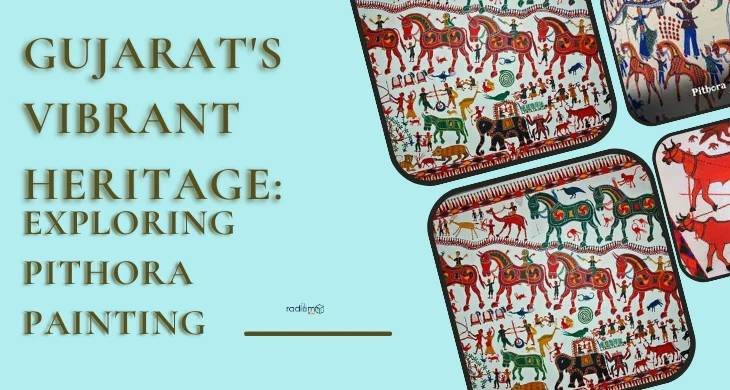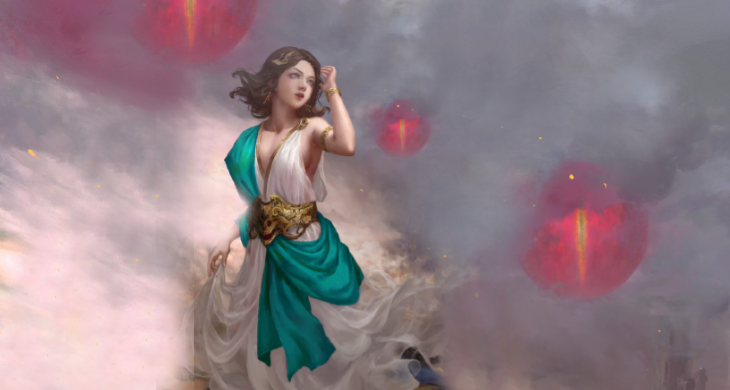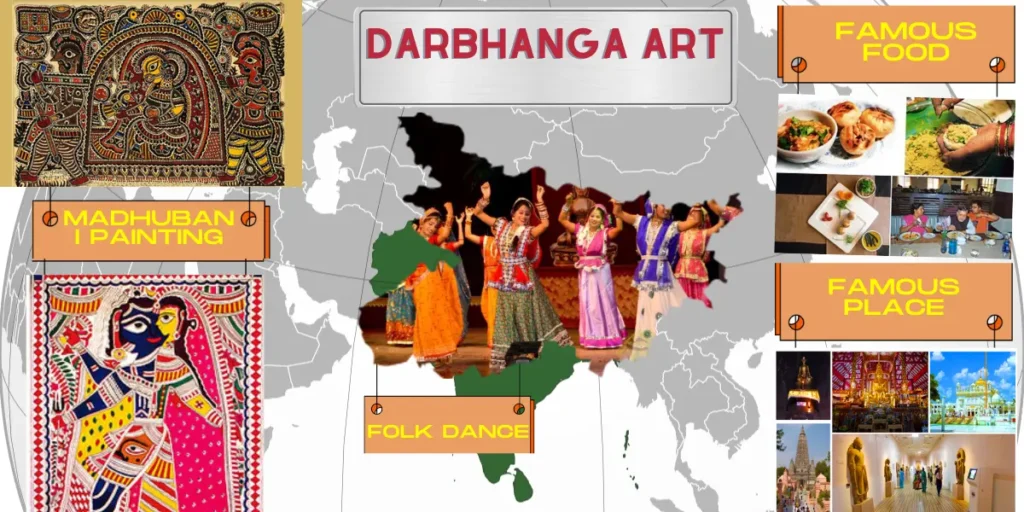Gujarat, a land of rich cultural traditions, holds a treasure trove of artistic expressions. Among these, Pithora Painting stands out as a vibrant and captivating folk art form. Delve into the world of Gujarat’s Pithora Painting and discover the stories, colors, and cultural significance woven into every stroke of this age-old tradition. Join us on a journey to explore the intricate artistry and deep-rooted heritage of Pithora Painting in Gujarat.
Origins and Historical Roots of Pithora Painting:
Pithora Painting, a captivating folk art form that graces the tribal regions of Gujarat, India, carries within its vibrant strokes a history that dates back centuries. In this segment, we embark on a journey through time to unravel the origins and historical roots of Pithora Painting, gaining insight into the cultural tapestry of Gujarat.
Ancient Beginnings: The origins of Pithora Painting are deeply rooted in the tribal communities of Gujarat. Historians trace its beginnings to the ancient traditions and rituals practiced by these indigenous groups. For generations, Pithora Painting has been an integral part of their lives, reflecting their connection to nature, spirituality, and daily existence.
Visual Narratives: Pithora Paintings are more than just aesthetically pleasing artworks; they serve as visual narratives. Each painting tells a story, capturing episodes from mythology, rituals, and tribal life. These narratives are not merely decorative but also play a crucial role in conveying cultural and religious messages.
Tradition Passed Down: The practice of Pithora Painting has been handed down from one generation to the next. The tribal communities have preserved this art form as a way of keeping their heritage alive. It has withstood the test of time, surviving through periods of change and modernization.
Mythological Significance: Many Pithora Paintings depict scenes from Hindu mythology, showcasing deities, legends, and rituals. These paintings are not only artistic expressions but also carry deep spiritual and mythological significance for the communities that create them.
The Artistic Process Behind Pithora Painting:
Pithora Painting, a vibrant and intricate folk art form from Gujarat, India, is not only a visual delight but also a testament to the artistic prowess of its creators. In this segment, we delve into the meticulous and captivating artistic process that breathes life into Pithora Paintings, exploring the materials, techniques, and symbolism that define this age-old tradition.
Materials and Canvas: Traditionally, Pithora Paintings are executed on cloth canvases, with silk and cotton being the primary choices. The selection of fabric is crucial, as it must withstand the natural pigments used in the painting process. These pigments are sourced from minerals, plants, and stones, ensuring that the colors are not only vibrant but also enduring.
Outlining and Detailing: The images in Pithora Paintings are outlined in bold black lines, providing a stark contrast against the colorful backdrop. These outlines serve as the foundation for the intricate detailing that follows. Fine brushes crafted from natural materials are employed to add depth, texture, and intricacy to the artwork.
Panel Division: Pithora Paintings are often divided into panels, each containing a specific scene from the narrative. These panels are separated by decorative borders, which themselves are adorned with floral motifs and geometric patterns. The meticulous division of the canvas enhances the storytelling aspect of Pithora Painting, creating a visual narrative akin to a storybook.
Symbolism and Textual Backdrop: One of the unique features of Pithora Painting is the incorporation of inscriptions in the Assamese script. These inscriptions provide a textual backdrop to the visual narrative, enhancing the storytelling aspect of the art. The script not only conveys information about the depicted scenes but also adds an element of cultural authenticity.
Traditional Techniques: The creation of Pithora Paintings requires a deep understanding of traditional techniques and symbolism. Artists meticulously blend colors, using their knowledge of tribal rituals, folklore, and mythology to infuse meaning into every stroke. This process requires both skill and intuition.
Visual Narratives: At its core, Pithora Painting is a medium of visual storytelling. The artistry lies not only in the execution but also in the ability to convey narratives, rituals, and cultural significance through vibrant and evocative imagery.
Themes and Narratives in Pithora Paintings:
Pithora Paintings, steeped in the rich cultural traditions of Gujarat’s tribal communities, are more than just colorful artworks—they are vessels of stories, myths, and rituals. In this section, we delve into the captivating themes and narratives that dominate the world of Pithora Painting, unraveling the tales that come to life with every brushstroke.
Religious and Mythological Depictions: A recurring theme in Pithora Paintings is the depiction of deities and scenes from Hindu mythology. The art form serves as a visual medium to convey stories of gods and goddesses, sacred rituals, and epic legends. Icons like Lord Krishna, Lord Rama, and Goddess Durga frequently grace these canvases, connecting the art to the spiritual beliefs of the communities.
Tribal Life and Everyday Scenes: Pithora Paintings are not limited to religious themes alone. They also capture the essence of tribal life, offering a glimpse into the daily activities, celebrations, and customs of the indigenous communities. Scenes of hunting, dancing, and communal gatherings come to life through vibrant colors and intricate detailing.
Fertility and Prosperity: Fertility and prosperity are essential elements of Pithora Painting symbolism. The paintings often include motifs and symbols associated with abundance, growth, and well-being. These representations hold cultural significance, as they are believed to bring blessings and good fortune to the community.
Rituals and Ceremonies: Pithora Paintings are integral to tribal rituals and ceremonies. They are not mere decorations but active participants in the events. The art form is deeply intertwined with religious festivals, tribal gatherings, and rites of passage. The paintings serve as visual aids, reinforcing the significance of the rituals and ceremonies.
Contemporary Expressions of Pithora Painting:
While deeply rooted in tradition, Pithora Painting has not remained static over the centuries. Today, contemporary artists and enthusiasts are redefining the boundaries of this ancient art form, infusing it with new ideas, styles, and interpretations. In this section, we explore the contemporary expressions of Pithora Painting, where tradition meets innovation.
Evolution of Styles: Contemporary Pithora Paintings often showcase an evolution of styles. Artists may experiment with color palettes, brush techniques, and compositions while staying true to the core themes and narratives. This evolution keeps the art form relevant and accessible to a wider audience.
Exploration of New Themes: While traditional themes remain central to Pithora Painting, contemporary artists have begun to explore new narratives and subjects. These may include social issues, environmental concerns, and personal expressions. This expansion of themes adds depth and diversity to the art form.
Fusion with Modern Art: In some instances, Pithora Painting has fused with modern and abstract art styles. This fusion results in unique and hybrid artworks that draw inspiration from both traditional and contemporary aesthetics. It showcases the adaptability of Pithora Painting in the face of changing artistic landscapes.
Cultural Significance of Pithora Painting:
Pithora Painting holds profound cultural significance within the tribal communities of Gujarat. It is not merely an art form but a vital aspect of their cultural identity, rituals, and heritage. In this section, we explore the profound cultural relevance of Pithora Painting and its role in shaping the identity of these communities.
Spiritual Connection: Pithora Painting is intrinsically linked to spirituality and religious beliefs. The depictions of deities, rituals, and sacred narratives connect the art form with the spiritual world. The paintings serve as visual aids during religious ceremonies, reinforcing the community’s faith and devotion.
Preservation of Traditions: The art of Pithora Painting plays a crucial role in preserving tribal traditions and customs. Through vibrant images and intricate details, it visually narrates stories of the past, ensuring that the collective memory of the community remains intact. It serves as a repository of their history and cultural practices.
Community Bonding: Creating Pithora Paintings often involves the participation of the entire community. This collaborative effort fosters a sense of unity and togetherness among tribal members. Painting sessions are not just artistic endeavors; they are communal gatherings that strengthen social bonds.
Preserving a Heritage:
Preserving cultural heritage is a collective responsibility, and Pithora Painting, with its deep-rooted traditions, is no exception. In this section, we explore the efforts and initiatives dedicated to safeguarding and ensuring the continuity of this cherished art form.
Documentation and Archiving: One of the primary steps in preserving Pithora Painting is thorough documentation and archiving. Artists, researchers, and organizations work together to catalog existing artworks, record the techniques used, and document the narratives depicted. This archival effort ensures that valuable insights are not lost to time.
Education and Workshops: Educational programs and workshops play a crucial role in passing down the knowledge and skills required for Pithora Painting. Master artists often become mentors, guiding the next generation of painters. These initiatives foster a sense of continuity and encourage young artists to embrace the tradition.
Reviving Lost Techniques: Over time, certain techniques and styles of Pithora Painting may have faded. Preservation efforts include rediscovering and reviving these lost techniques. Artists study historical paintings and collaborate with elders to recreate authentic renditions of the art.
Promoting Cultural Exchange: Cultural exchange programs and collaborations with artists from diverse backgrounds introduce Pithora Painting to a global audience. These interactions not only create opportunities for artists but also raise awareness about the art form’s cultural significance.
Conservation of Natural Resources: Preservation also extends to the conservation of natural resources used in Pithora Painting. Efforts are made to ensure sustainable sourcing of pigments and materials, reducing the environmental impact while preserving the traditional color palette.
FAQS:
1. What is Pithora Painting, and where does it originate?
Pithora Painting is a traditional folk art form that originates from the tribal regions of Gujarat, India. It is characterized by vibrant colors and intricate depictions of deities, rituals, and daily life.
2. What materials are used in Pithora Painting?
Traditional Pithora Paintings are created using natural pigments, such as crushed stones and plants, on cloth canvases. Brushes made from natural materials are often used.
3. What are the main themes depicted in Pithora Paintings?
Pithora Paintings often revolve around religious and mythological themes, portraying deities, rituals, and legends. They also capture scenes from everyday tribal life.
4. Is Pithora Painting still practiced today?
Yes, Pithora Painting is still practiced by tribal communities in Gujarat. While traditional forms persist, contemporary artists have also adapted the art to new styles and themes.
5. What is the cultural significance of Pithora Paintings?
Pithora Paintings hold immense cultural significance as they are used in rituals, ceremonies, and festivals among tribal communities.
6. How can one support the preservation of Pithora Painting heritage?
Supporting local artisans, participating in workshops, and promoting awareness about Pithora Painting can contribute to its preservation. Additionally, engaging with organizations dedicated to preserving folk art is essential.
7. Are Pithora Paintings only limited to Gujarat?
While Gujarat is the primary hub of Pithora Painting, similar art forms with distinct regional variations exist in other states of India, such as Rajasthan and Madhya Pradesh.
Conclusion:
Conclusion: Preserving the Colors of Gujarat’s Heritage
In the heartlands of Gujarat, where traditions breathe and culture thrives, Pithora Painting stands as a testament to the state’s rich and vibrant heritage. Our exploration of this captivating folk art has unveiled a world where colors speak, stories unfold, and traditions endure.
From its ancient origins to its contemporary expressions, Pithora Painting has weathered the sands of time, and its significance remains undiminished. It continues to be a bridge connecting the past with the present, weaving tales of deities, rituals, and everyday life into vibrant canvases.
While Pithora Paintings cultural significance is undeniable, it faces challenges in the modern era. The preservation of this heritage is not just the responsibility of the artists but also of those who appreciate the depth and beauty it brings to our lives. It calls for a collective effort to ensure that the canvas of Gujarat’s traditions remains colorful for generations to come.




